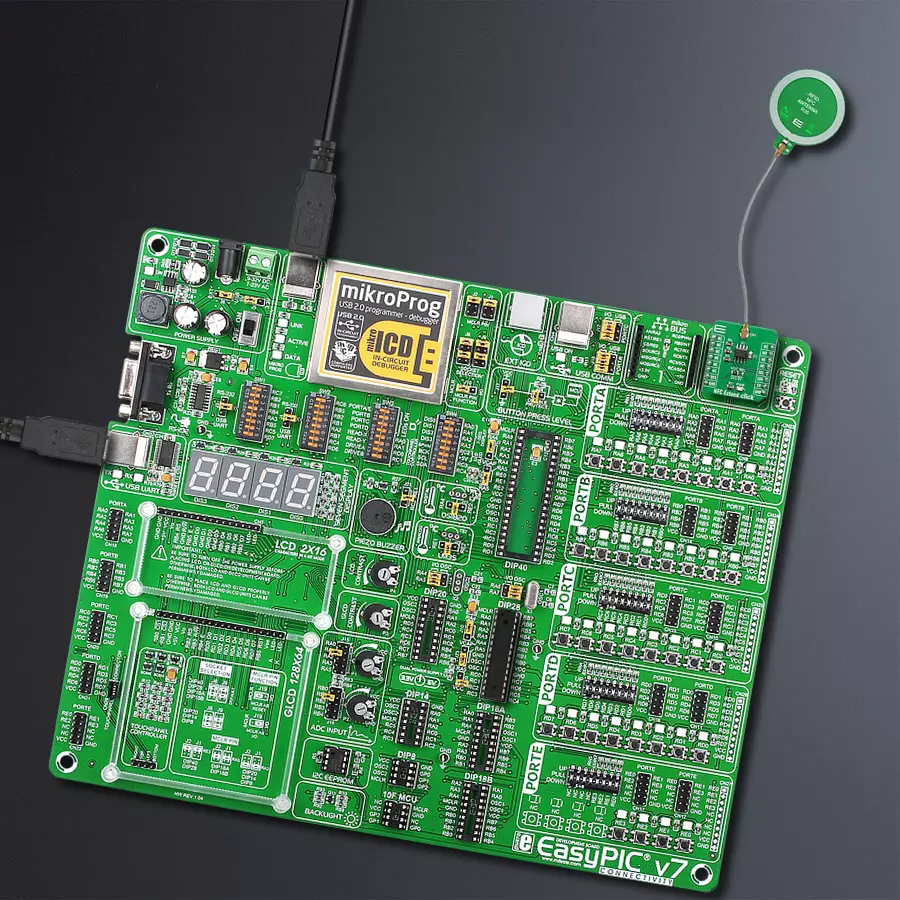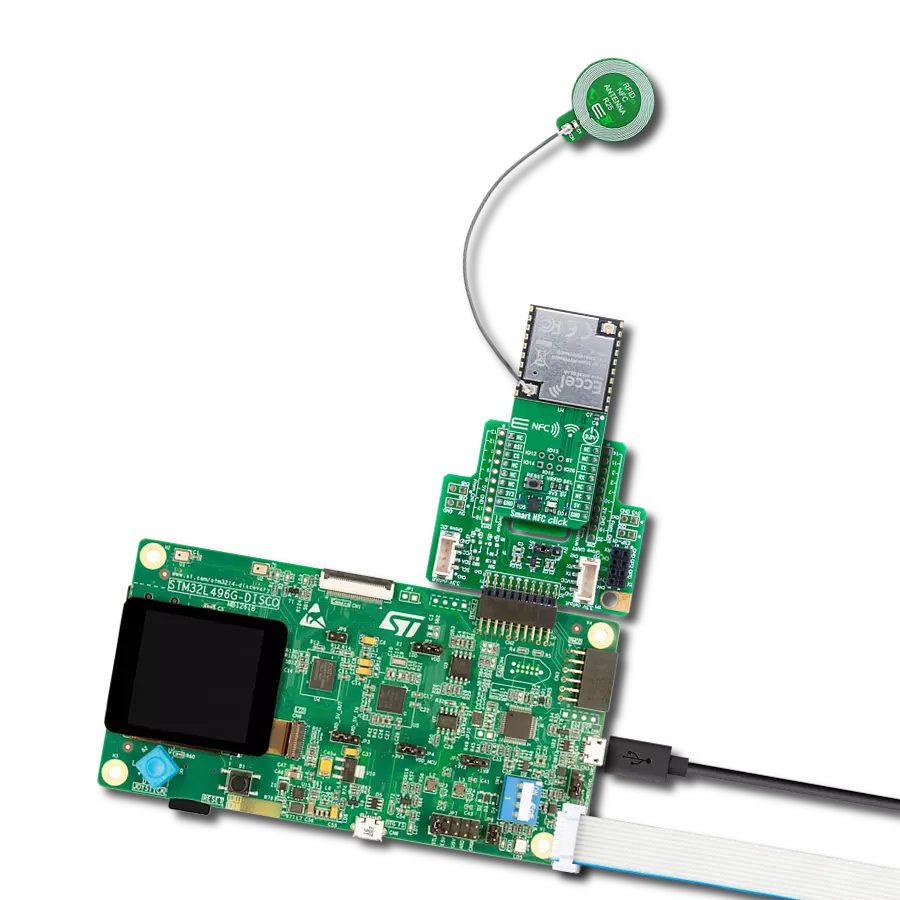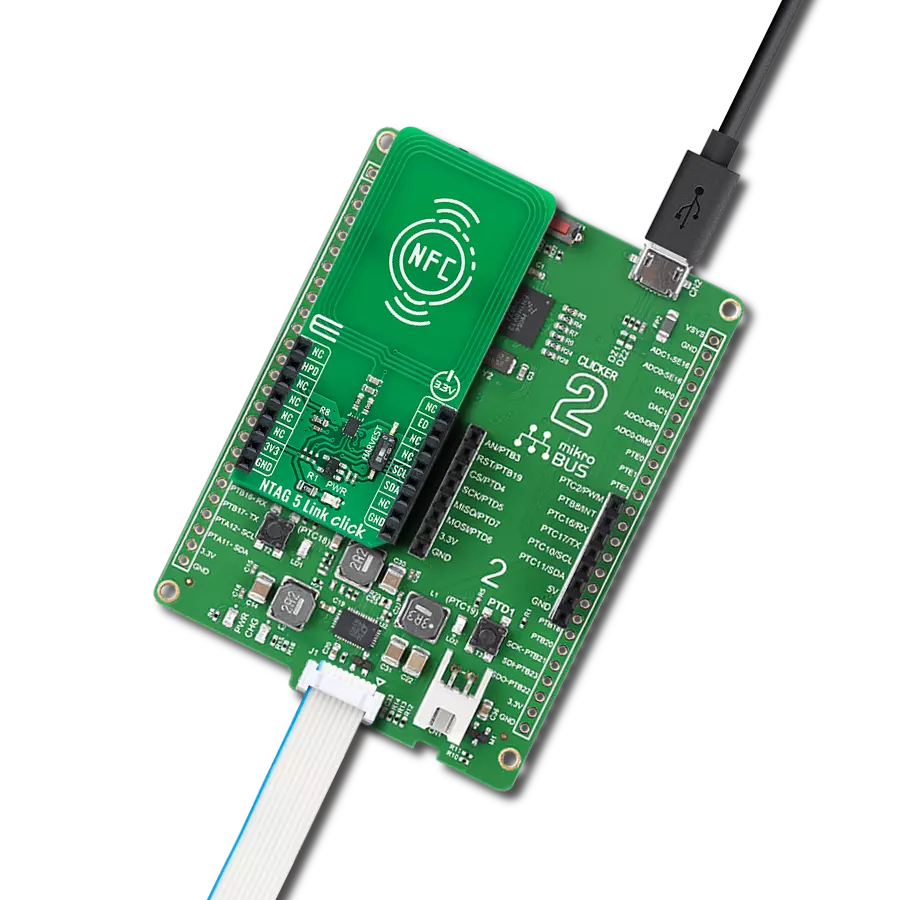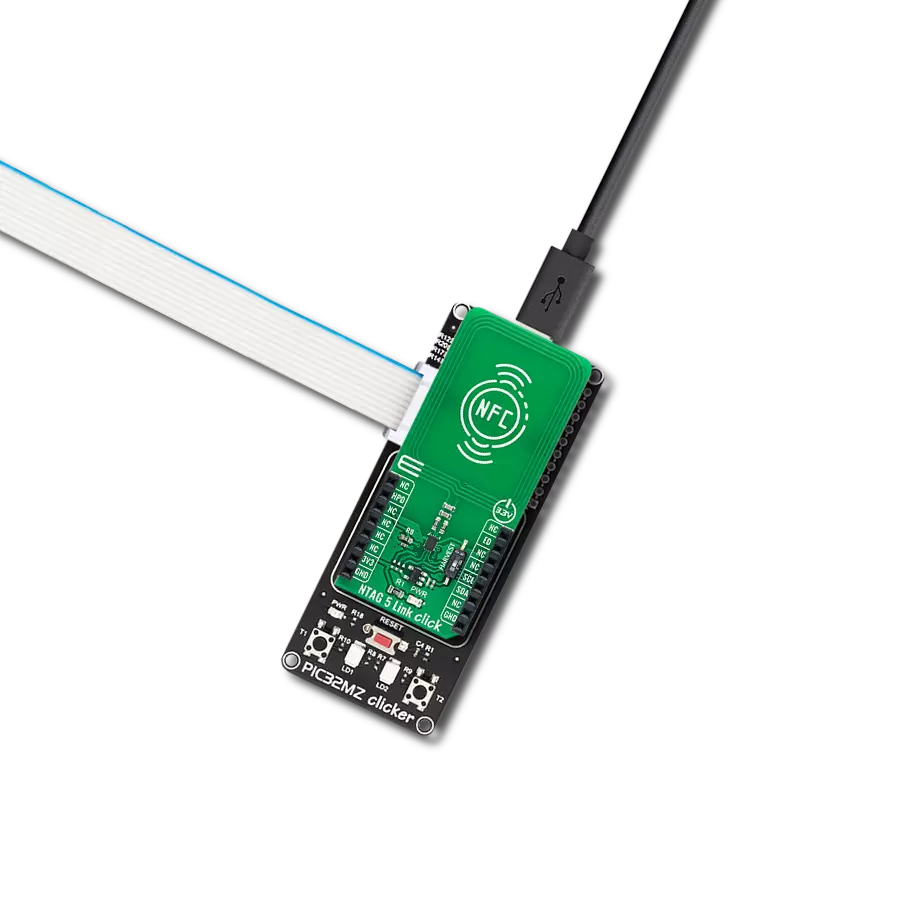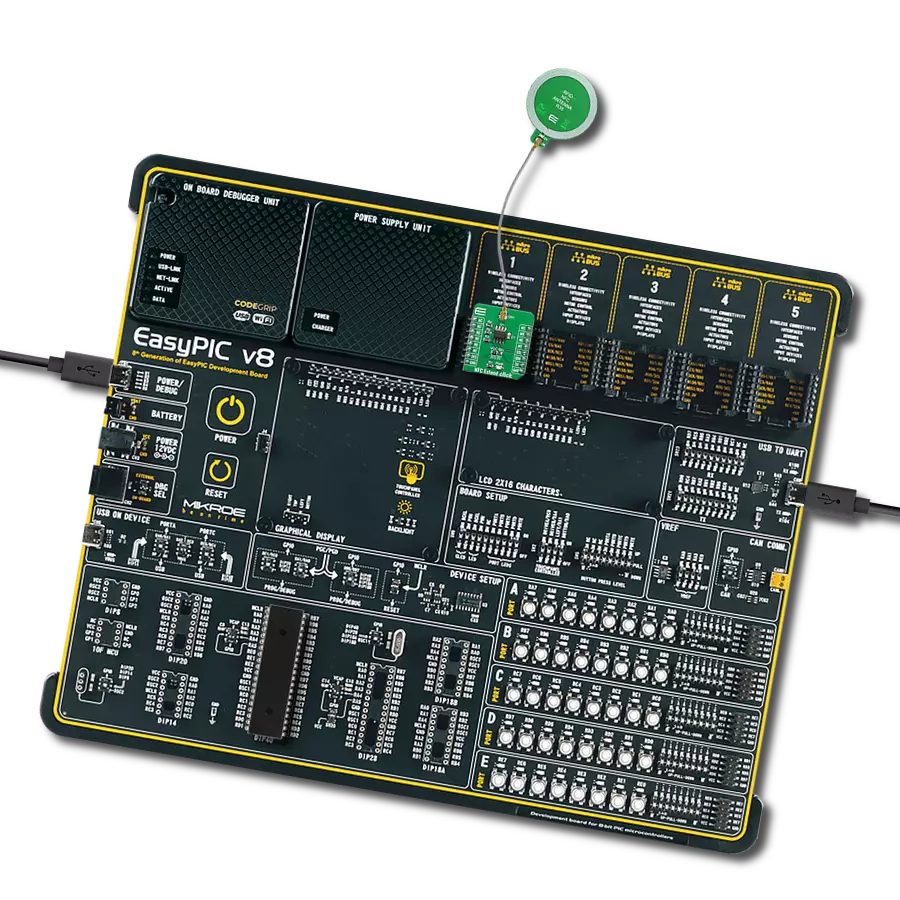With NFC Extend, you have the power to shape your NFC experience with custom antennas, allowing you to personalize and adapt your tags to fit unique requirements
A
A
Hardware Overview
How does it work?
NFC Extend Click is based on the ST25DV16K, a compact NFC tag IC from STMicroelectronics. The Click board™ itself has a reasonably small number of components because most of the interface and EEPROM memory circuitry is already integrated on the ST25DV16K IC. The I2C / SMBus compatible serial interface lines, along with the GPO pin, which also works in the open drain configuration, are pulled up by the on-board resistors. The 2-Wire lines are routed to the respective I2C lines of the mikroBUS™ (SCK and SDA), while the GPO pin of the main IC is routed to the INT pin of the mikroBUS™. Depending on the application requirements various shapes and sizes of 13.56 MHz external antenna can be used by connecting them to CN1 (male U.FL) connector. This Click can utilize new antennas that we have recently
released. The ST25DV16K uses the I2C/SMBus compatible communication interface, offering a fast transfer mode (FTM), to achieve a fast link between RF and contact worlds, via a 256 byte buffer called Mailbox. This mailbox dynamic buffer of 256 byte can be filled or emptied via either RF or I2C. There is also the INT pin available, which indicates incoming event to the contact side, like RF Field changes, RF activity in progress, RF writing completion or Mailbox message availability. The built in energy harvesting element can deliver µW of power when external conditions make it possible. The integrated RF management allows the NFC Extend Click to ignore RF requests. All these features can be programmed by setting static and/or dynamic registers of the ST25DV16K. The ST25DV16K can be partially customized
using configuration registers located in the E2 system area. More information about all the registers can be found in the ST25DV16K datasheet. However, provided library contains functions that simplify the use of the NFC Extend Click. The included application example demonstrates their functionality and it can be used as a reference for custom design. This Click board™ can operate with either 3.3V or 5V logic voltage levels selected via the VCC SEL jumper. This way, both 3.3V and 5V capable MCUs can use the communication lines properly. Also, this Click board™ comes equipped with a library containing easy-to-use functions and an example code that can be used as a reference for further development.
Features overview
Development board
EasyPIC v7 is the seventh generation of PIC development boards specially designed to develop embedded applications rapidly. It supports a wide range of 8-bit PIC microcontrollers from Microchip and has a broad set of unique functions, such as a powerful onboard mikroProg programmer and In-Circuit debugger over USB-B. The development board is well organized and designed so that the end-user has all the necessary elements in one place, such as switches, buttons, indicators, connectors, and others. With four different connectors for each port, EasyPIC v7 allows you to connect accessory boards, sensors, and custom electronics more efficiently than ever. Each part of
the EasyPIC v7 development board contains the components necessary for the most efficient operation of the same board. An integrated mikroProg, a fast USB 2.0 programmer with mikroICD hardware In-Circuit Debugger, offers many valuable programming/debugging options and seamless integration with the Mikroe software environment. Besides it also includes a clean and regulated power supply block for the development board. It can use various external power sources, including an external 12V power supply, 7-23V AC or 9-32V DC via DC connector/screw terminals, and a power source via the USB Type-B (USB-B) connector. Communication options such as
USB-UART and RS-232 are also included, alongside the well-established mikroBUS™ standard, three display options (7-segment, graphical, and character-based LCD), and several different DIP sockets. These sockets cover a wide range of 8-bit PIC MCUs, from PIC10F, PIC12F, PIC16F, PIC16Enh, PIC18F, PIC18FJ, and PIC18FK families. EasyPIC v7 is an integral part of the Mikroe ecosystem for rapid development. Natively supported by Mikroe software tools, it covers many aspects of prototyping and development thanks to a considerable number of different Click boards™ (over a thousand boards), the number of which is growing every day.
Microcontroller Overview
MCU Card / MCU
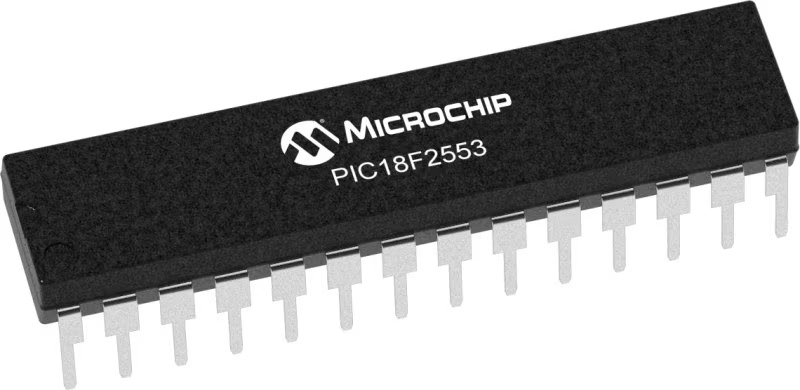
Architecture
PIC
MCU Memory (KB)
32
Silicon Vendor
Microchip
Pin count
28
RAM (Bytes)
2048
You complete me!
Accessories
Circular NFC R35 Antenna is a circular-shaped PCB antenna designed to be used as an extension of development boards and placed remotely on desired places such as plastic casing, existing products, or even under displays. The antenna is designed in a circular shape with a diameter of 35mm (35x42mm WxL) and seven coil turns. It's also important to mention that this antenna can be used for NFC and RFID applications that work on 13.56MHz frequency.
UMCC - Ultraminiature Coax Connector is an ultra-low profile 1.37mm diameter coax female-to-female interconnect solution that meets the ever-growing demand for miniaturization in next-generation wireless applications. Crafted as double-ended jumpers and inter-series assemblies, the UMCC cable also offers PCB jack receptacles for seamless board mount applications. With a length (L) of 200mm, a 2.5mm mated height (H), and a 50 Ohm characteristic impedance, the UMCC Connector Type III ensures optimal performance across a broad frequency range from DC to 6 GHz.
Used MCU Pins
mikroBUS™ mapper
Take a closer look
Click board™ Schematic

Step by step
Project assembly
Software Support
Library Description
This library contains API for NFC Extend Click driver.
Key functions:
nfcextend_i2c_set- This function writes data to the chip.nfcextend_i2c_get- This function reads data from the chip.nfcextend_digital_read_int- This function reads the digital signal from the INT pin.
Open Source
Code example
The complete application code and a ready-to-use project are available through the NECTO Studio Package Manager for direct installation in the NECTO Studio. The application code can also be found on the MIKROE GitHub account.
/*!
* \file
* \brief NfcExtend Click example
*
* # Description
* This example showcases how to configure and use the NFC Extend Click. The Click is an NFC tag
* interface which uses the I2C serial interface and an RF link interface in order to communicate.
* The example requires the ST25 NFC Tap application which can be downloaded to your phone.
*
* The demo application is composed of two sections :
*
* ## Application Init
* This function initializes and configures the logger and Click modules.
*
* ## Application Task
* This function waits for the interrupt signal, after which it expects data transfers. Once
* some data has been detected it will open a communication channel with the device transmitting
* it and show the received data in the UART console.
*
* \author MikroE Team
*
*/
// ------------------------------------------------------------------- INCLUDES
#include "board.h"
#include "log.h"
#include "nfcextend.h"
// ------------------------------------------------------------------ VARIABLES
static nfcextend_t nfcextend;
static log_t logger;
uint8_t default_password[ NFCEXTEND_PASSWORD_LEN ] = { 0 };
// ------------------------------------------------------- ADDITIONAL FUNCTIONS
void wait_for_interrupt ( )
{
uint8_t int_pin_flag;
uint16_t timer_counter;
int_pin_flag = nfcextend_digital_read_int( &nfcextend );
timer_counter = 0;
while ( ( int_pin_flag == 1 ) && ( timer_counter <= 300 ) )
{
Delay_ms ( 1 );
timer_counter++;
int_pin_flag = nfcextend_digital_read_int( &nfcextend );
}
if ( timer_counter <= 300 )
{
int_pin_flag = nfcextend_digital_read_int( &nfcextend );
while ( int_pin_flag == 0 )
{
int_pin_flag = nfcextend_digital_read_int( &nfcextend );
}
}
timer_counter = 0;
}
// ------------------------------------------------------ APPLICATION FUNCTIONS
void application_init ( )
{
log_cfg_t log_cfg;
nfcextend_cfg_t cfg;
uint8_t init_status_flag;
/**
* Logger initialization.
* Default baud rate: 115200
* Default log level: LOG_LEVEL_DEBUG
* @note If USB_UART_RX and USB_UART_TX
* are defined as HAL_PIN_NC, you will
* need to define them manually for log to work.
* See @b LOG_MAP_USB_UART macro definition for detailed explanation.
*/
LOG_MAP_USB_UART( log_cfg );
log_init( &logger, &log_cfg );
log_info( &logger, "---- Application Init ----" );
// Click initialization.
nfcextend_cfg_setup( &cfg );
NFCEXTEND_MAP_MIKROBUS( cfg, MIKROBUS_1 );
nfcextend_init( &nfcextend, &cfg );
nfcextend_password_present( &nfcextend, default_password );
Delay_ms ( 100 );
init_status_flag = nfcextend_default_cfg( &nfcextend );
Delay_ms ( 100 );
if ( 1 == init_status_flag )
{
log_printf( &logger, " * App init failed. *\r\n" );
}
else if ( 0 == init_status_flag )
{
log_printf( &logger, " * App init done. *\r\n" );
}
log_printf( &logger, "-----------------------\r\n" );
}
void application_task ( )
{
nfcextend_block_t block;
uint8_t temp_buf[ 258 ];
uint16_t message_len;
uint16_t cnt;
block.memory_area = NFCEXTEND_MEMORY_DYNAMIC;
block.reg_addr = NFCEXTEND_DYNAMIC_REG_MB_CTRL;
block.data_buf = temp_buf;
block.len = 1;
wait_for_interrupt( );
nfcextend_i2c_get( &nfcextend, &block );
if ( ( temp_buf[ 0 ] & 0x04 ) == 0x04 )
{
block.reg_addr = NFCEXTEND_DYNAMIC_REG_MB_LEN;
block.data_buf = &temp_buf[ 0 ];
wait_for_interrupt( );
nfcextend_i2c_get( &nfcextend, &block );
message_len = temp_buf[ 0 ] + 1;
block.memory_area = NFCEXTEND_MEMORY_MAILBOX;
block.reg_addr = NFCEXTEND_MAILBOX_REG_BYTE_0;
block.data_buf = &temp_buf[ 0 ];
block.len = message_len;
wait_for_interrupt( );
nfcextend_i2c_get( &nfcextend, &block );
log_printf( &logger, " ** Message length: %u Bytes**\r\n", message_len);
log_printf( &logger, " ------------------------------\r\n" );
log_printf( &logger, " ** Message START **\r\n" );
for ( cnt = 0; cnt < message_len; cnt++ )
{
log_printf( &logger, " %u : 0x%x\r\n", cnt, ( uint16_t ) temp_buf[ cnt ] );
}
log_printf( &logger, " ** Message END **\r\n" );
log_printf( &logger, " ------------------------------\r\n" );
}
}
int main ( void )
{
/* Do not remove this line or clock might not be set correctly. */
#ifdef PREINIT_SUPPORTED
preinit();
#endif
application_init( );
for ( ; ; )
{
application_task( );
}
return 0;
}
// ------------------------------------------------------------------------ END










